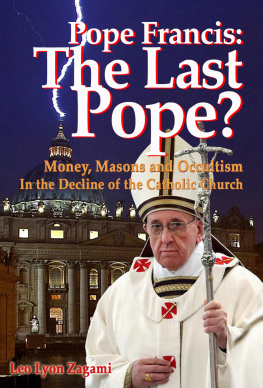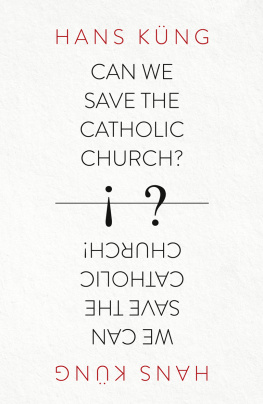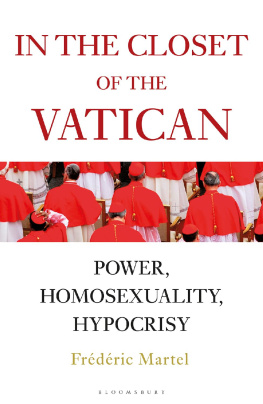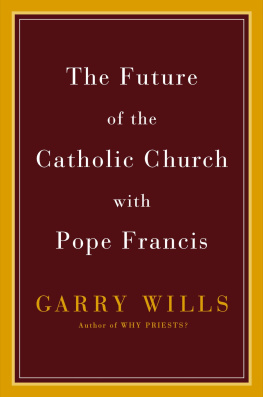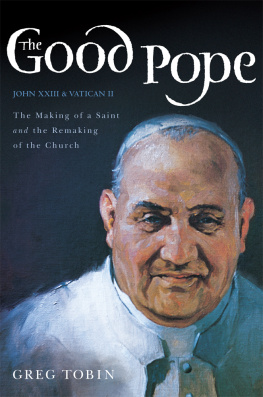Also by
John L. Allen, Jr.
THE GLOBAL WAR ON CHRISTIANS
Dispatches from the Front Lines
of Anti-Christian Persecution
OPUS DEI
An Objective Look Behind the Myths and Reality of the
Most Controversial Force in the Catholic Church
THE FUTURE CHURCH
How Ten Trends Are Revolutionizing
the Catholic Church
ALL THE POPES MEN
The Inside Story of How the Vatican Really Thinks
THE RISE OF BENEDICT XVI
The Inside Story of How the Pope Was Elected and
Where He Will Take the Catholic Church

Copyright 2015 John L. Allen , Jr.
Published by TIME Books, an imprint of Time Home Entertainment Inc.
1271 Avenue of the Americas, 6th floor New York, NY 10020
All rights reserved. No part of this book may be reproduced in any form or by any electronic or mechanical means, including information storage and retrieval systems, without permission in writing from the publisher, except by a reviewer, who may quote brief passages in a review. TIME and the Red Border design are protected through trademark registration in the United States and in the foreign countries where TIME magazine circulates.
e-ISBN 9781618936066
We welcome your comments and suggestions about Time Books.
Please write to us at:
TIME Books, Attention: Book Editors,
P.O. Box 11016, Des Moines, IA 50336-1016
If you would like to order any of our hardcover
Collectors Edition books, please call us at
800-327-6388, Monday through Friday, 7 a.m.8 p.m.,
or Saturday, 7 a.m.6 p.m., Central Time.
To Shannon, for 23 years of love and support.
TABLE of CONTENTS
Introduction
IT WAS THE KIND OF VATICAN MEETING that normally shuffles along for two weeks without making headlines, but in October 2014 a tumultuous synod of bishops captured both the excitement and the alarm that Pope Francis is generating in the Catholic Church. Roughly 260 bishops, clergy and laity from around the world gathered in Rome to debate issues that have embodied the Churchs identity for generations: family life, marriage and sexual morality. There have been 26 such synods since the first in 1967, and theyve generally been tame affairs. This time, however, the gathering was filled with intrigue and controversy.
Two sides squared off: traditionalists, unnerved by the new pope, and progressives, hoping to spur Francis on to even greater change. On the right, prelates complained of a plot to suppress their voices and led an internal revoltone disgruntled cardinal even told the media that the pope was sowing the seeds of confusion and owed the world an apology. Inside the synod hall, another rose to accuse a cardinal advocating a permissive line on divorce of spreading sickness and disease. On the left, reformers groused about a lack of nerve, and many saw the final document of the synod as a disappointing concession on issues such as a new welcome for homosexuals, recognizing positive values in non-traditional relationships and the possibility of allowing Catholics who divorce and remarry outside the Church to receive communion. Yet both sides could agree on at least one thing: Francis had let loose a battle for the soul of Roman Catholicism.
Given the upheaval and acrimony that surfaced over the two weeks, it was tempting to frame the 2014 synod of bishops as a defeat for the pope, proof that he cant control the forces hes generatedin effect, that his leadership has put the Church in danger of spinning out of control. There were even hints that Francis might rethink his plans to call a second, larger synod in October 2015, on the grounds he was lucky this one didnt fall apart completely and he might not want to tempt fate again.
Then, at the close of the meeting, Francis broke his silence, giving a 15-minute talk that seemed to capture the spirit of the Church he wants to lead. He noted that at the beginning of the event he had called on bishops to speak boldly and hold nothing back and said he would have been disappointed if there hadnt been animated discussion.
In the most critical portion of his speech, Francis ticked off several temptations that the Church must avoid if its to resolve its challenges successfully. It must not succumb to a hostile rigidity, a fussy legalism devoid of compassion and subtlety. At the same time, it must also reject what he called a destructive do-goodism and a false mercy, a touchy-feely morality incapable of calling sin by its name. The Church must not impose impossible burdens on people, he said, but it also must not come down off the cross by abandoning its core principles in order to win approval. Francis recognized that both sides that emerged at the synodreformers pushing the Church toward its future and conservatives determined not to jettison its pasthad a point, and that each perspective wouldnt be fully Catholic without the other. He drew a five-minute standing ovation, including prelates who not long before had been virtually at one anothers throats.
Francis effectively laid out the program of a moderate pontiff, fully committed to the more than 2,000 year old faith of the Catholic Church and equally committed to cajoling the Church into a deeper and more positive dialogue with the world around it. He wants peoples first impression of Catholicism to be one not of judgment but rather of welcome; he trusts that whatever verdicts the Church delivers will be better received if they come in the context of a loving embrace. To achieve that, he knows he needs to bring all ideological camps along with him.
For claritys sake, the labels right wing and left wing are an inexact fit for the Catholic Church, especially where the hierarchy is concerned. By secular standards, there are no liberal bishopswho would favor abortion rights, gay marriage and playing down the role of religion in public life. In the Church, a liberal bishop usually means someone committed to Church teaching but flexible and accommodating in the way its applied, while a conservative believes in drawing lines in the sand. The difference is more about attitude than substance. In that sense, there are clearly both liberals and conservatives in the Church Francis leads, and he wants to be the pope for both.
Ultimately, the 2014 synod of bishops signaled Pope Franciss ambition to lead the Catholic Church to the political center, to the geographical and cultural margins of the world and to the heart of the Christian gospel with his message of mercy.

THOSE FAMILIAR WITH Jorge Mario Bergoglio as the cardinal of Buenos Aires in Argentina before March 2013 will tell you his election to the papacy was destiny fulfilled. Bergoglio had been the runner-up in the 2005 papal conclave that elected Benedict XVI and, given the anti-establishment mood after Benedicts resignation, the choice of a Latin American outsider with a reputation as a strong manager seemed plausible. Bergoglios age at the time, 76, put him on most handicappers B-list, but since Benedict had been elected at 78, even that wasnt seen as disqualifying.
What utterly astonished even his closest friends, however, is the kind of pope hes turned out to be. This is a pontiff who has been splashed across more magazine covers than Scarlett Johansson, who has been googled almost as often as Justin Bieber and who beat out the likes of George Clooney when he was named Esquire s Best Dressed Man of 2013. He has poll numbers that politicians and celebrities would drool over and more than 16.8 million followers on Twitter. His instantly famous line about gaysWho am I to judge?was among the most-quoted phrases of 2013, earning him person of the year honors from not only TIME magazine but also the pro-gay magazine The Advocate , which showed the popes smiling face with a NO H8 sticker. After it emerged that Francis had briefly worked as a bouncer at an Argentine bar as a young man, NBCs Today show breathlessly proclaimed him the coolest pope ever.
Next page

